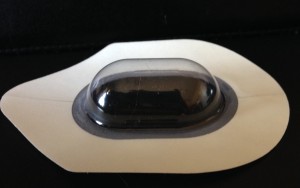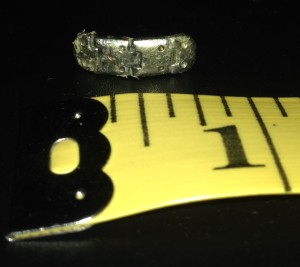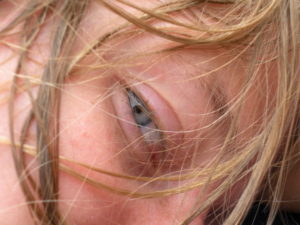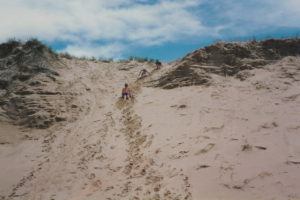Initial Treatment
In the hospital immediately following surgery, nurses taped a plastic bubble over my eye, providing a greenhouse effect. Moisture built up in the bubble and kept my eye from drying out. They also put lubricant in my eye that was a messy gel that liquefied and coated my eye.
The surgeon suggested putting a gold weight in, which I learned was actually titanium. Having it sewn into my eyelid was good news because I had learned that a small weight would help the lid close more effectively. The bad news is that you don’t get a gold weight if your face movement will return quickly. It was a reminder of the long road ahead.
Different samples were taped to my eyelid to get the correct weight – just enough to close my eye but not too heavy or I wouldn’t be able to open it. After going back and forth, a decision was made. The appropriate weight was heavier than ideal but necessary due to the extent of my paralysis. The weight had links in it like a watch so it would curve with my eyelid. (the picture shows the size, a little over a half-inch.)
Having the platinum weight sewn into my eyelid was a short procedure done while awake with local anesthetic. Well, short according to the doctors. It felt like the longest 40 minutes of my life. It was very strange to have someone cut into my eyelid and insert a foreign object. Then they stitched me up and sent me back to my room. My procedure was done while I was still in the hospital, but frequently they are added several weeks or months later.
I continued to use the bubble only at night and then with time I was able to only use nighttime gel. Some doctors recommend scotch taping the eye shut or the use of an eye patch. My doctor didn’t want me to do those things as he felt that I could scratch my cornea. As with anything in medicine there are different opinions on treatment and its whatever a doctor and patient agree to. Mine preferred bubbles.
I’m not very knowledgeable about other options but I’ll list them for info. Googling any of them will provide more detail.
– A procedure called a Tarsorrhaphy partially sews the eyelids partially closed until movement returns.
– Eyelid Palpebral Spring surgery is another option, which assists with blinking.
– Lateral Canthoplasty is a procedure done by shortening the lower eyelid to keep the lower eyelid from falling from the eye.
Anyway, back to my journey. I now had a black eye to add to my existing appearance issues – a row of 29 staples behind my ear from brain surgery and a motionless right face. I’ll never forget the self-consciousness as I was wheeled out of the hospital and crawled into my waiting car. I couldn’t believe what I was living but the pain reminded me that I was indeed alive.
In Part Three I’ll talk about recovery and how things have changed — or not — over time.
Note: Pictured above is a NitEye Dry Eye Comforter Eye Bandage. They aren’t on google but can be found here: NitEye




